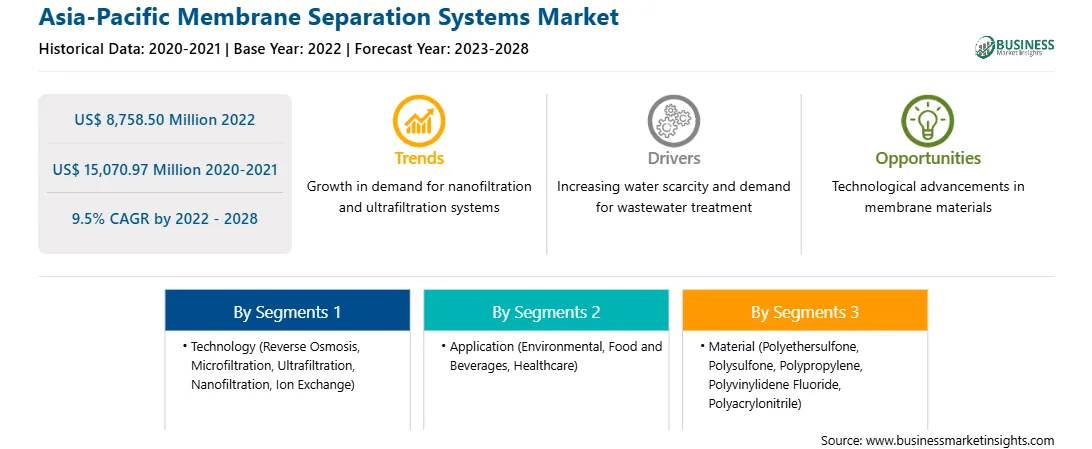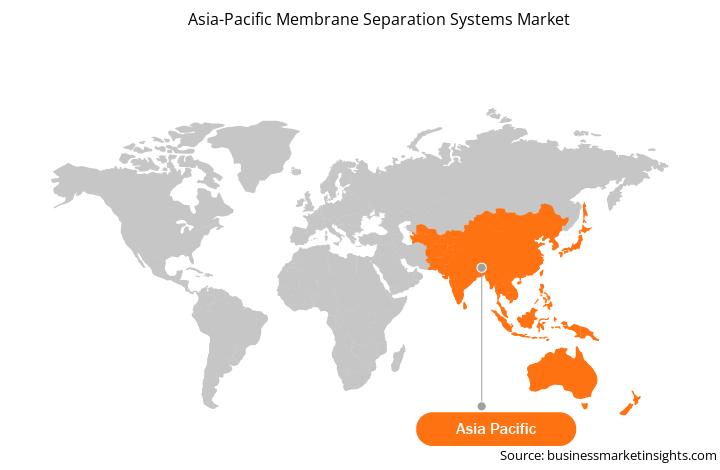The Asia-Pacific membrane separation systems market is expected to grow from US$ 8,758.50 million in 2022 to US$ 15,070.97 million by 2028. It is estimated to record a CAGR of 9.5% from 2022 to 2028.
Development of High-Performance Nanostructured Material Boosts Asia-Pacific Membrane Separation
Systems Market Growth
Recent development in high-performance nanostructured material; new production technologies, such as 3D printing; and high-performance computing possibilities are expected to open new horizons for membrane separation processes. Polymers represent the dominant material family of membrane separation processes. Polymeric membranes are the first choice of the membrane separation industry because they are economical and serve a wide range of applications. (CA), polyacrylonitrile (PAN), polyimide, polycarbonate (PC), polyethylene (PE), polypropylene (PP), and polytetrafluoroethylene (PTFE) are common examples of polymeric membranes. Generally, polymers such as polyvinylidene fluoride (PVDF) ultrafiltration membranes are embedded with nanomaterial—such as metal/metal oxide or carbon nano tubes (CNTs)—to improve the performance. The labs mainly use nanostructured membrane materials. Nanofiltration witnesses a high demand in the oil & gas sector to process natural gases such as coal bed methane. According to the statement by Guangdong Rural Credit Union in the 14th Five-Year (2021–2025) Plan for Energy, the union plans to build natural gas production and storage facility in the Guangdong province of China. Several new plans across the region would increase the production output of natural gas, thereby surging the use of nanofiltration in the oil & gas sector.
Asia-Pacific Overview
The Asia-Pacific membrane separation systems market is segmented into China, Japan, India, South Korea, Australia, Bangladesh, Sri Lanka, Southeast Asia, and the Rest of Asia-Pacific. China held the substantial share of the market in 2022. China is a well-developed country in Asia-Pacific with a well-established healthcare system. The country is home to various medical, pharmaceutical, and biotechnology product manufacturing companies operating in the global market. China also has ~300 contract research organizations, such as Pharmaron, Shanghai Medicilon, Shanghai ChemPartner, and JOINN Laboratories. These organizations and medical & pharmaceutical companies are among the prime end users of membrane separation systems. Drugs and biologics manufacturers and beverage producers in the food industry are prone to global market competition that encourages these companies to introduce new drugs and biologics that will also increase the applications of membrane separation systems. Further, according to CEIC Data, water consumption in China increased to 592,020.000 million Cub meters in 2021 from 581,290.000 million Cub meters in 2020. According to Articles 1 and 3 of the Water Pollution Prevention and Control Law of the People's Republic of China (Amended in 2017), the principles prioritize prevention, control, and protection of drinking water sources. Thus, the increasing water consumption and government laws for water treatment will drive the demand for various pharmaceuticals, food & beverages, and other commercial and residential demands in China, fueling the Asia-Pacific membrane separation systems market growth during the projected years.
Strategic insights for the Asia-Pacific Membrane Separation Systems provides data-driven analysis of the industry landscape, including current trends, key players, and regional nuances. These insights offer actionable recommendations, enabling readers to differentiate themselves from competitors by identifying untapped segments or developing unique value propositions. Leveraging data analytics, these insights help industry players anticipate the market shifts, whether investors, manufacturers, or other stakeholders. A future-oriented perspective is essential, helping stakeholders anticipate market shifts and position themselves for long-term success in this dynamic region. Ultimately, effective strategic insights empower readers to make informed decisions that drive profitability and achieve their business objectives within the market. The geographic scope of the Asia-Pacific Membrane Separation Systems refers to the specific areas in which a business operates and competes. Understanding local distinctions, such as diverse consumer preferences (e.g., demand for specific plug types or battery backup durations), varying economic conditions, and regulatory environments, is crucial for tailoring strategies to specific markets. Businesses can expand their reach by identifying underserved areas or adapting their offerings to meet local demands. A clear market focus allows for more effective resource allocation, targeted marketing campaigns, and better positioning against local competitors, ultimately driving growth in those targeted areas.Asia-Pacific Membrane Separation Systems Strategic Insights

Asia-Pacific Membrane Separation Systems Report Scope
Report Attribute
Details
Market size in 2022
US$ 8,758.50 Million
Market Size by 2028
US$ 15,070.97 Million
Global CAGR (2022 - 2028)
9.5%
Historical Data
2020-2021
Forecast period
2023-2028
Segments Covered
By Technology
By Application
By Material
Regions and Countries Covered
Asia-Pacific
Market leaders and key company profiles
Asia-Pacific Membrane Separation Systems Regional Insights

Asia-Pacific Membrane Separation Systems Market Segmentation
The Asia-Pacific membrane separation systems market is segmented based on technology, application, material, and country.
Based on technology, the Asia-Pacific membrane separation systems market is segmented into reverse osmosis, microfiltration, ultrafiltration, nanofiltration, ion exchange, and others. The reverse osmosis segment held the largest market share in 2022.
Based on application, the Asia-Pacific membrane separation systems market is segmented into environmental, food and beverages, healthcare, and others. The environmental segment held the largest market share in 2022.
Based on material, the Asia-Pacific membrane separation systems market is segmented into polyethersulfone (PES), polysulfone (PSF), polypropylene (PP), polyvinylidene Fluoride (PVDF), polyacrylonitrile (PAN), and others. The others segment held the largest market share in 2022.
Based on country, the Asia-Pacific membrane separation systems market has been categorized into China, Japan, India, South Korea, Australia, Bangladesh, Sri Lanka, Southeast Asia, and the Rest of Asia-Pacific. Our regional analysis states that China dominated the market share in 2022.
3M, Alfa Laval AB, DuPont de Nemours Inc, GEA Group AG, Hydranautics, Koch Separation Systems Inc, MANN+HUMMEL International GmbH & Co KG, Pentair Plc, ProMinent GmbH, and Veolia Water Technologies SASU are among the leading companies operating in the Asia-Pacific membrane separation systems market.
The Asia-Pacific Membrane Separation Systems Market is valued at US$ 8,758.50 Million in 2022, it is projected to reach US$ 15,070.97 Million by 2028.
As per our report Asia-Pacific Membrane Separation Systems Market, the market size is valued at US$ 8,758.50 Million in 2022, projecting it to reach US$ 15,070.97 Million by 2028. This translates to a CAGR of approximately 9.5% during the forecast period.
The Asia-Pacific Membrane Separation Systems Market report typically cover these key segments-
The historic period, base year, and forecast period can vary slightly depending on the specific market research report. However, for the Asia-Pacific Membrane Separation Systems Market report:
The Asia-Pacific Membrane Separation Systems Market is populated by several key players, each contributing to its growth and innovation. Some of the major players include:
The Asia-Pacific Membrane Separation Systems Market report is valuable for diverse stakeholders, including:
Essentially, anyone involved in or considering involvement in the Asia-Pacific Membrane Separation Systems Market value chain can benefit from the information contained in a comprehensive market report.